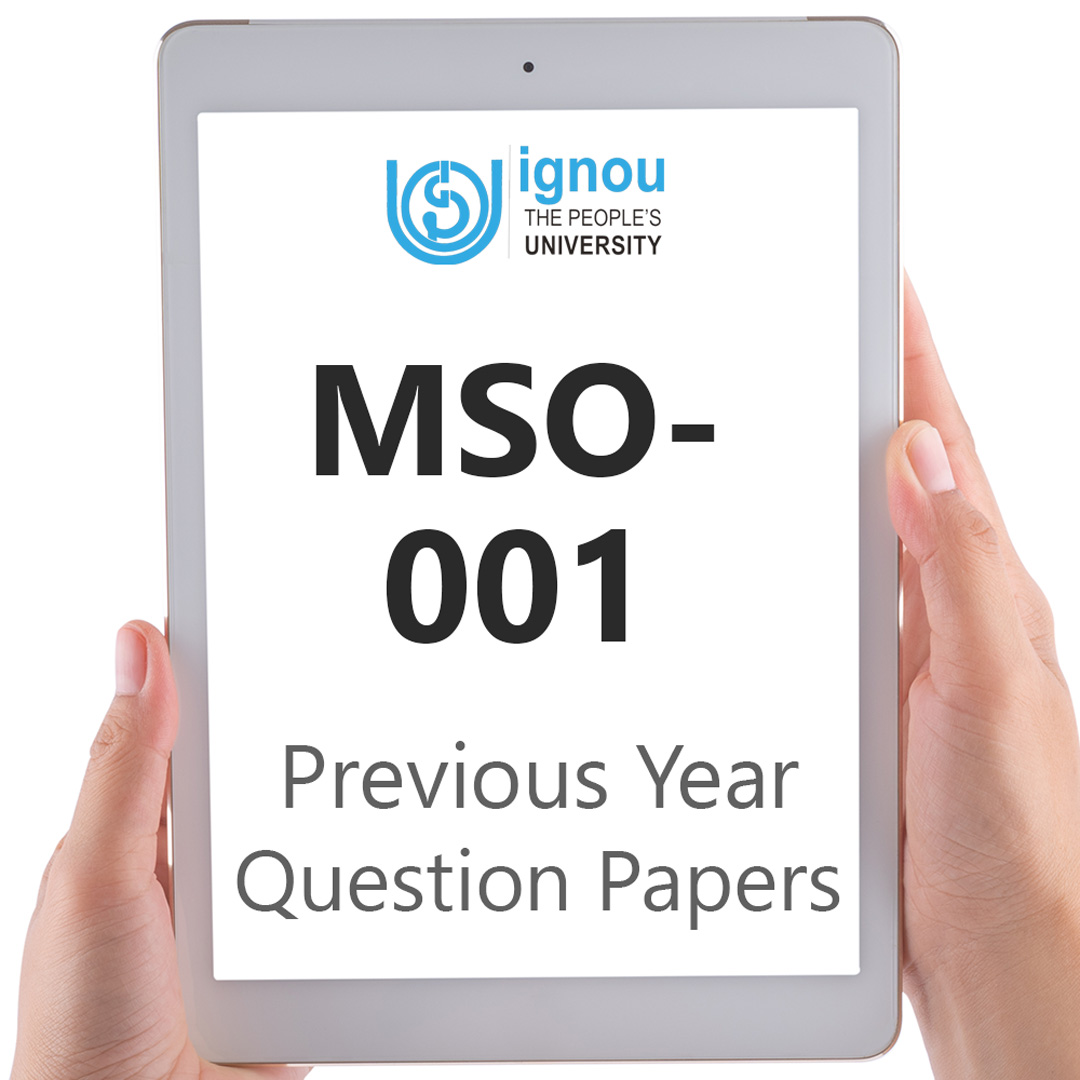If you are looking for MSO-001 IGNOU Solved Assignment solution for the subject Sociological Theories and Concepts, you have come to the right place. MSO-001 solution on this page applies to 2022-23 session students studying in MSO courses of IGNOU.
MSO-001 Solved Assignment Solution by Gyaniversity
Assignment Code: MSO-001/AST/TMA/2022-23
Course Code: MSO-001
Assignment Name: Sociological Theories and Concepts
Year: 2022-2023
Verified by Professor
Answer any five questions selecting at least two from each of the sections. Your answers should be in about 500 words each.
Section-I
Q1) Explain the relationship between theory and paradigm.
Ans) The nature, relevance, and numerous sociological ideas are:
In the first, the discipline's early pioneers invested a lot of work into establishing its reputation. The only reason sociology was maybe able to evolve as a distinct area of study during its classical age was possibly due to the huge efforts made by notable scholars at that time.
In reality, the historical period that follows in the second half is the moment in both chronological and conceptual history when the discipline of sociology was able to move past its classical phase.
During this time, sociology achieved several important advances and resolved certain issues from the classical era.
In the third portion, the most recent advancements in sociological theory are covered. Here, we can see how sociology is growing both as a field and as a topic. During this time, sociology established itself as a substantial, developed, independent topic with a distinct identity.
How different misunderstandings about the nature and categories of sociological theories were clarified in the fourth section.
It should be highlighted in the fifth part that while sociological theory as it exists now has been able to address a number of difficulties and problems, doing so has never been easy.
The Concept of Paradigm
The idea that advancement within a field, particularly in science, does not occur gradually but rather fairly rapidly was initially put forth by Kuhn. The structure of the scientific revolution is the name of one of Kuhn's books. The sudden charges are described by Kuhn as paradigm changes.
According to Kuhn, science, and hence social science, goes through its process in three distinct phases:
Prescientific Phase
Normal Science
Paradigm Shift
Theories of explanation are initially unfinished and complement one another. One of the ideas eventually becomes established, ushering in the era of conventional science. During this stage, a dominant theory or group of theories what Kuhn refers to as a paradigm emerges.
When a paradigm shift occurs, it means that the prior theories have been rendered obsolete. This is a natural process, according to Kuhn, and it keeps happening as more knowledge is learned and new hypotheses are developed. The best course of action at this juncture is to either change the theories or reject them in favour of a different set of dominant or competing theoretical explanations that provide a more thorough and superior justification for science, social science, and worldview as a whole. We must emphasise that, in Kuhn's view, a paradigm shift entails a relatively radical, if not complete, replacement of the prior accepted theories in both science and social science. In other words, the prior hypotheses cannot be compared. It is a full shift. A paradigm shift involves changes in conventions, attitudes, and mores as well as the way language is used and the creation of new concepts, words, and meanings.
To put it another way, a paradigm shift refers to a new way of seeing the world, including its perception, perspective, and general attitudes of the global community. In the age of globalisation, which has seen the postmodern paradigm shift, local contexts are seen as the primary object of research and taking into account broad or mega theories is seen as neither prudent nor useful. The idea of a paradigm contains two components. The first is that which encompasses the entire thing and includes all of its component pieces on subsets. It includes every step in a scientific or social science procedure. This paradigm exists everywhere. The beliefs and practises that uncover at the second level support the global/societal paradigm that is now in place.
Q2) Compare and contrast the functional approaches of Radcliffe-Brown and Malinowski.
Ans) Radcliffe-Brown claimed that it was not based on actual history but rather conjectural history a phrase we used earlier. It lacked scientific significance because it was pseudo-historical. Malinowski saw traditional evolutionism as a realm of speculative reconstructions.
Structural-Functional Approach of Radcliffe-Brown
Radcliffe-Brown abandons the search for institutional origins and histories as well as the means by which cultural traits have moved around the world in favour of viewing each civilisation as a functionally connected system with general laws or functions. He agrees that Durkheim offered the first thorough analysis of the concept of function, which is based on a contrast between social life and organic life. The theory of teleology may be included into functionalism, according to Radcliffe-Brown. Radcliffe-Brown acknowledges the range of circumstances required for the persistence of various systems.
Malinowski enthusiastically promoted the term functionalism, which Radcliffe-Brown despises. His argument is that ideologies, schools of thought, philosophies, and areas of opinion are all types of isms. Neither of them exist in science. It has study techniques, choosing those that are thought to be the most effective for learning. A scientist does not have an intense attachment to any particular method. For him, they are all equally significant and valuable, but their practical usefulness comes in conducting a successful investigation of a phenomenon in accordance with accepted standards of scientific inquiry.
The Functionalism of Malinowski
Malinowski, unlike Radcliffe-Brown, founded the Functional School. Functional analysis, he says, explains anthropological facts at all stages of development based on their purpose and significance in the larger cultural system. He assumes that every practise, thing, idea, and belief has a duty to perform and symbolises a fundamental truth in every society's working structure. Malinowski starts with the individual's needs, while Radcliffe-Brown starts with society's. In contrast to Radcliffe-sociological Brown's functionalism, Malinowski's psychological functionalism emphasises the individual.
In his method, Malinowski makes a distinction between three levels: biological, social structural, and symbolic. For an individual to survive, a certain set of demands must be met at each of these levels. The continued existence of larger entities depends on his life. These three levels, according to Malinowski, make up a hierarchy. The biological system is at the bottom, followed by the social-structural system and then the symbolic system. The manner that needs are met at one level will have an impact on how they are met at the levels that follow. The biological demands are the most fundamental, but this does not entail reductionism because each level has its own distinct traits and needs, and culture evolves from interactions between levels. Culture is Malinowski's strategy.
Since humans separated from their simian predecessors, culture has served their biological demands. It consists of all the tangible and immaterial artefacts they've made. This system meets needs. Malinowski's functionalism is called bio-cultural functionalism since culture satisfies biological needs. Malinowski and Radcliffe-Brown have another difference. Radcliffe-Brown considers Malinowski's definition of culture an epiphenomenon. According to him, studying culture is included in social structure. What anthropologists witness and hear about other peoples is not as observable as social structure since culture resides in peoples' minds. If social anthropology could be rigorously explored, Radcliffe-Brown might establish it as a natural science subfield.
Q3) Explain the concept of liberty in the writings of Isaiah Berlin.
Ans)
Isaiah Berlin: Negative and Positive Philosophy
Two Concepts of Liberty, Isaiah Berlin's inaugural lecture, has established itself as one of the 20th century's most important contributions to political philosophy. Berlin distinguishes between positive and negative liberty, and according to him, these various interpretations of liberty are produced as the responses to two distinct inquiries:
What is the area where a person or group of people should be allowed to accomplish or be what they are capable of doing or being, free from outside interference? The negative liberty of an agent is described. In this context, political liberty simply refers to the space in which a man can act without interference from others.
Instead, what or who is the source of interference or control that can lead someone to choose to do or be this rather than that? The agent's positive liberty is what we want to describe.
Negative Liberty
Thomas Hobbes was the most eloquent advocate of the most basic form of negative liberty. He defined a free man rather broadly as someone who, in the things that his power and intelligence allow him to accomplish, is not prevented from carrying out his desires. When coercion is considered as the intentional interference of other agents, negative liberty is sometimes seen as the absence of compulsion. Hobbesian negative liberty, which is threatened by coercion as well as other preventative measures, is frequently contrasted with views that suggest that mere limitations restrict liberty.
Berlin is adamant that we should establish a distinction between the importance of negative liberty and the circumstances that permit the exercise of liberty. In a nation where the majority of people are uneducated, there may therefore be press freedom. For the majority, the circumstance that would indicate literacy's independence does not exist. Berlin would contend that in these conditions, illiteracy does not equate to a loss of freedom. A society that fails to educate its citizens to the point where they can utilise fundamental liberties clearly has a problem, but that problem need not involve a lack of freedom.
The following is a summary of Berlin's historical analysis of liberty:
Self-Control and Self-Realisation: This entails working with my own impulses to organise, enhance, and eliminate them in accordance with my idea of what is good or right for me to do or be. This is a comprehensive exposition of freedom of action at the centre of a complex idea.
Paternalism: This idea is especially pertinent in situations where your paternalistic interference establishes or maintains circumstances of autonomy for me that my own actions undermine.
Social Self Control: Self-control is the process through which people choose their own actions and use strategies to restrain their emotions, thoughts, and behaviour.
State Servitude: An imprudent citizen who lacks the ability to apply immediate restraint and lacks the vision to enact or support social coercion devices might nonetheless achieve freedom indirectly and second-hand if the state implements the required control, notwithstanding his opposition or lack of involvement.
Section-II
Q1) Examine the relationship between identity and identification.
Ans) The word "identification" is frequently used in several contexts. Sigmund Freud first used term to describe how a kid interacts with and assimilates external people and objects to itself in psychology. In psychoanalytical interpretations of socialisation processes, the idea served as the main tool. Modern social scientists are aware of the limitations of such claims since, as we all know, people do not always accept belonging to ethnic groupings in the manner. Allport's contributions to the history of the development of identity construction and identity theories paved the way for connecting ideas of identity to well-known sociological theories of role and reference group put forth by Ralph Linton and Merton, respectively. It will be better if theories of identification are proposed as explanations for motivation in social interactions, according to Foote, who felt that Linton's role theory lacked a satisfying account of motivation.
Foote set himself apart from Freud in how he used the term "identification." Identification, according to Foote, is when a person adopts and commits to a certain identity or set of identities. Identification begins with naming, which implied that the person to whom the name was given embraced and vowed to uphold that identity. In other words, he consents to being placed in a category based on his family, genealogy, kinship, religion, occupation, or other characteristics. This definition of identification allows for the adoption of these identities. It encourages ascription to established categories and fosters the development of "selfhood." The process of self-actualization and self-discovery is started; it's a voluntary process that's not compelled by society. That people can "combine and modify identities by conscious decision more successfully than was conceivable for a child or a young person" as they get older is a different storey.
J. Milton Yinger investigates identity as a result of the assimilation process. According to him, "people from different groups may start to believe that they are a part of the same society a new society that has been blended from their cultures of origin." The United States of America continued to be the context for identification theorists. Several populations that immigrated to the US in the last 200 years have experienced varied stages of identity. These tribes occasionally gave in to the prevailing white culture, while other times they defended their traditional ethnic identities, refusing to associate themselves with it.
It is also true that throughout American history, certain people have chosen to identify as Indians, choose to live in traditional village settings, and accept the position of village chief. Identification is sometimes the dominant causal factor in the ethnic order; at other times it is more neatly dependent on the levels of integration, acculturation, and amalgamation, writes Yinger in his conclusion. It is significant to remember that self-identification and identification by others are not always related. Individuals or groups may identify as belonging to a certain nation or region, although this affiliation is not always shared by others. Examples that might suit this concept include ethnic conflicts in the Northeast or displaced populations in Kashmir. When Yinger states that group cohesion among members of a group may limit identification even with an open society, he is making a very crucial point.
Q2) What is sovereignty? Discuss the difference between internal and external sovereignty.
b) Sovereignty is a presumption about power. The fundamental tenet of modern political activity, both nationally and internationally, is sovereignty. The ability to rule is known as authority. The notion of sovereignty is the idea that a state's government is supreme and independent. It has absolute authority over everyone who resides within its territorial jurisdiction and is separate from other governmental bodies. In scholarly discourse, the idea of sovereignty has proven contentious. The different ways in which it is used to allude to independence and autonomy are mostly responsible for this. While the second is an idea of power and capability, the first is a notion of authority and right. Political economists and political sociologists typically use the latter idea, whereas historians, international lawyers, and political theorists typically deal with the former. As we continue to examine this fundamental idea in political theory, it is important to keep in mind the two fundamentally distinct conceptions of sovereignty that do exist.
Internal Sovereignty
The discussion on sovereignty that has gone on thus far has primarily focused on internal sovereignty. The precise location of sovereignty has been the subject of much modern political philosophy. Early political theorists like Machiavelli, Bodin, and Hobbes held the view that power should be concentrated in the hands of a single person, a king.
The main benefit of granting sovereignty to one person was that it would become indivisible and be conveyed in a single voice that could exercise ultimate authority. The succeeding theorists, like Locke and Rousseau, broke with this absolutist view of sovereignty. They opposed monarchical government in favour of the idea of popular sovereignty, which holds that the people themselves have the final say. Most people agree that the foundation of contemporary democratic thought is this notion of popular sovereignty.
External Sovereignty
From the inside of a state, sovereignty is the highest kind of authority, while from the outside, it is the power to govern oneself. The term "external sovereignty" describes a state's standing in the international system and, consequently, its sovereign independence from other states. Sovereignty and state power have grown to be synonymous in international affairs. It is helpful to think of constitutional independence as an aspect of external sovereignty. The state is autonomous from other states because it has a constitution, whether it is written or not, democratic, or not.
Being distinct from other organisations of a comparable nature constitutes state sovereignty in the sense of constitutional independence. A state loses its sovereignty the instant it creates a constitutional connection with another state because it is now a part of a larger framework. In other words, external sovereignty indicates that the state is under the control of no higher political authority. The area, people living there, resources there, and activities that take place there are all within the exclusive sovereignty of the sovereign state. Additionally, external sovereignty creates anarchy, or the absence of a supreme authority over the nations, as the fundamental precondition of international relations.





